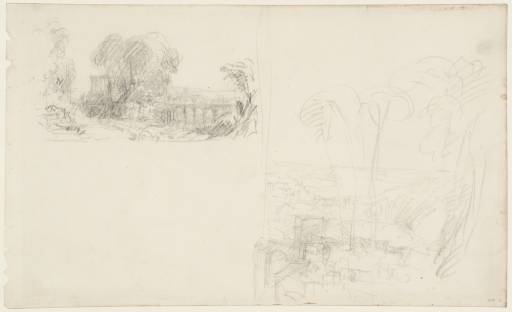Joseph Mallord William Turner Two Studies for Classical Subjects c.1807-19
Joseph Mallord William Turner,
Two Studies for Classical Subjects
c.1807-19
Joseph Mallord William Turner 1775–1851
Two Studies for Classical Subjects circa 1807–19
D08088
Turner Bequest CXV 5
Turner Bequest CXV 5
Pencil on white wove lightweight writing paper, 230 x 381 mm
Inscribed by John Ruskin in red ink ‘5’ bottom right
Blind-stamped with Turner Bequest monogram at the bottom right of each composition
Stamped in black ‘CXV 5’ bottom right
Inscribed by John Ruskin in red ink ‘5’ bottom right
Blind-stamped with Turner Bequest monogram at the bottom right of each composition
Stamped in black ‘CXV 5’ bottom right
Accepted by the nation as part of the Turner Bequest 1856
Exhibition history
1989
Turner: The Second Decade: Watercolours and Drawings from the Turner Bequest 1800–1810, Tate Gallery, London, January–March 1989 (17, reproduced, as circa 1806).
References
1909
A.J. Finberg, A Complete Inventory of the Drawings of the Turner Bequest, London 1909, vol.I, p.314, CXV 5, as circa 1809–10.
1996
Gillian Forrester, Turner’s ‘Drawing Book’: The Liber Studiorum, exhibition catalogue, Tate Gallery, London 1996, pp.15, 24 note 81.
Unlike the other works from the Studies for Liber sketchbook, this sheet has been worked in pencil rather than brown watercolour washes, and includes two distinct compositions. They are artificial exercises in classical landscape, fundamentally derived from the paintings of Claude Lorrain (mostly known to Turner through Richard Earlom’s engravings of Claude’s Liber Veritatis drawings – see general Liber Studiorum introduction). Wash studies made on adjacent pages (Tate D08084–D08087; Turner Bequest CXV 1–4) probably show or are derived from the scenery along the Thames around Isleworth, where Turner had lived in 18051 and made many half-topographical, half-classical drawings (for example in the Studies for Pictures: Isleworth sketchbook: Tate; Turner Bequest XC).
The drawing with the bridge and trees occupying the top left quarter is perhaps a variation on the Liber composition Bridge and Goats (for drawing see Tate D08146; Turner Bequest CXVII R). The latter is generally thought to have been composed in the opening stages of the Liber project, possibly at its very beginning in 1806; the 1807 watermarks elsewhere in the present sketchbook would therefore preclude the pencil sketch being the first idea for the subject, and the similarity in the placing of such generic elements may simply be fortuitous. There may be a statue or figure at the centre of the drawing, in front of the trees.
The second drawing, taking up the right-hand half of the sheet and effectively an upright composition, appears to show buildings or ruins in the foreground, dropping away beyond the trees to a distant landscape of hills and lakes or rivers, perhaps with a town on the left. There are general affinities, again perhaps fortuitous, with Turner’s large, upright classical landscape Mercury and Herse, exhibited in 1811 (private collection).2 Among the Liber designs, The Temple of Minerva Medica and Scene in the Campagna (drawings respectively Tate D08128, D08141; Turner Bequest CXVII A, N) are in a similar spirit.
In the absence of specific evidence, the span of the Liber Studiorum’s active publication, 1807–19, is given here as a date range (as it is for various other unpublished designs). The earlier published date of circa 1806 is clearly not viable in view of the sketchbook’s 1807 watermarks, as noted above.
Technical notes:
The paper is from a batch watermarked ‘J Whatman | 1807’.1 The upper left composition is sketched and developed with right-handed shading, typical of Turner’s technique; the other has been sketched but not yet shaded.2 There are a few stray marks or strokes of brown wash along the very edge below the right-hand composition, possibly carried over on Turner’s fingertips from one of the watercolour compositions in the sketchbook.
This sheet was recorded by Finberg in 1909 as apparently still being in the sketchbook, but if so it was subsequently removed before the book was badly damaged by immersion in the basement of the Tate Gallery during the Thames flood of January 1928. His number, ‘5’, corresponds with the red ink folio numbers inscribed in the book by Ruskin. The whole sheet was extracted, leaving jagged tears around the stitching holes, and not has not been trimmed further.
Verso:
Blank, save for a few splashes or offsets of pale brown wash.
Matthew Imms
May 2006
How to cite
Matthew Imms, ‘Two Studies for Classical Subjects c.1807–19 by Joseph Mallord William Turner’, catalogue entry, May 2006, in David Blayney Brown (ed.), J.M.W. Turner: Sketchbooks, Drawings and Watercolours, Tate Research Publication, December 2012, https://www

